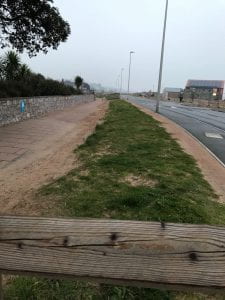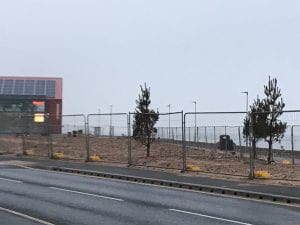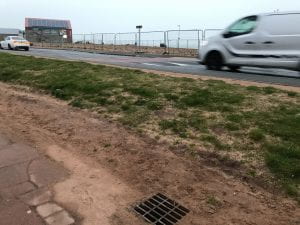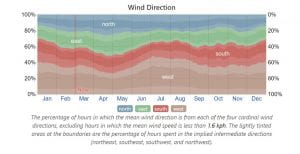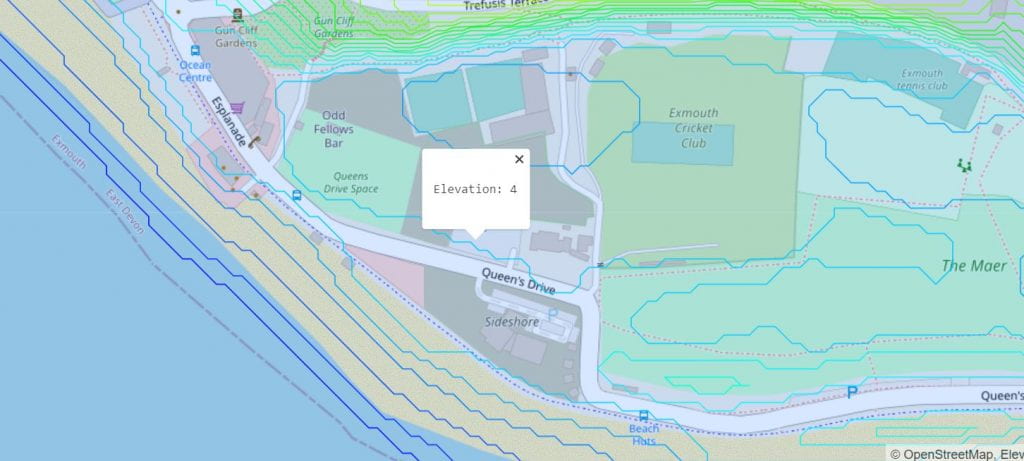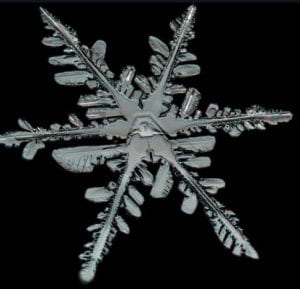
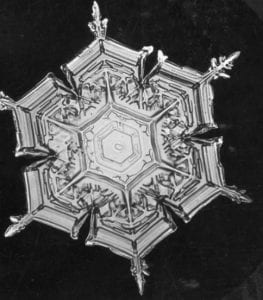 In nature there are a limited number of patterns but an infinite number of variations. Take a snowflake: there are no two snowflakes that are the same although they are all formed in a similar way.
In nature there are a limited number of patterns but an infinite number of variations. Take a snowflake: there are no two snowflakes that are the same although they are all formed in a similar way.
The air temperature and the humidity, to some degree, determine the basic shape of the snowflake. We get needle-like crystals at -1.6°C and flat, plate-like crystals at -15°C. The shape of one arm of a snowflake is determined by the atmospheric conditions as it falls; the temperature or humidity might change as it falls and this affects how the water crystal grows and also explains why the six arms are identical. They all experience the same conditions at the same point. Anyway, these patterns are symmetrical and fascinating, so what about others.
In nature we can find waves, lobes, spirals, clouds, branching patterns and scatters all of which are patterns of growth, and nets which are patterns of lateral tension, distribution of weight, storage of energy and shrinkage.
I am going to look at three patterns in a bit more detail: branching patterns, explosion patterns and spirals.
Branching patterns

Orchid flower

Alocasia sanderiana
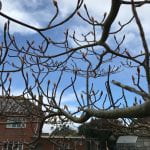
Cornus controversa ‘Variegata’
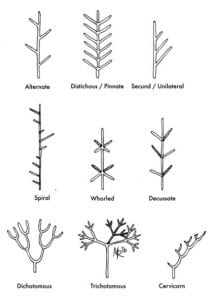
With thanks to Meghan Rocktopus
Branching patterns (sometimes called dendritic or fractal patterns) can be one of the easiest patterns to spot. They can be found in leaves, roots, rivers and our circulatory and nervous systems to name but a few places. Looking closely at the three photos taken of plants inside and outside my house, I can see that they have slightly different ways of branching. A little research on the internet suggests that there might be 19 different branching patterns. The Alocasia looks more like a distichous or pinnate branching with the orchid more of a dichotomous branching and the Cornus a trichotomous. This isn’t really important knowledge for permaculture purposes, just of interest to me.
Branching patterns are found where there is a gathering and dispersal of materials or energy. At a micro level they are essential for the efficient exchange of gases and fluids with the environment due to the maximised surface area.
So how could we use these as permaculture designers? Branching patterns are well-suited to roads and paths where something needs to be distributed across a wide area. Branching patterns can also relate to the organisation of people such as a large, hierarchical company where who line manages who is depicted. For an example of a branching pathway (cervicorn – branching like antlers) used in a permaculture design see p11 of Mobile home garden design by Aranya. Look on the right-hand side of the design next to the decking.
Exploding patterns
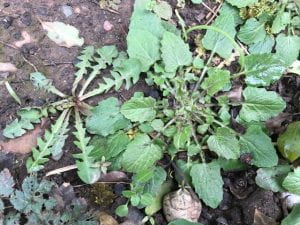
Weeds in my garden!
Back to the snowflake patterns which would fit into this category. The image shows two weeds in my garden that both have an exploding pattern in 2d with the leaves lying flat on the ground. You can see how they layer over each other in the weed on the right (I’m not sure what it is called) and in fact it is almost symmetrical with 10 leaves on the lower layer. It is obvious how the arrangement of leaves allows it to gain maximum sunshine and I do wonder if it does well in slightly shady spots where this photo was taken. There is a very direct route between the central point and each external point in complete contrast to a spiral where the central point is a long way away from the end point if you follow the spiral around.
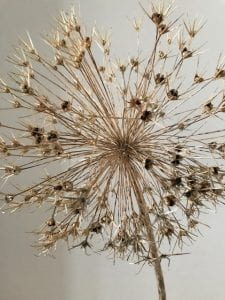 This explosion, however, is the dried flower of Allium x ‘Globemaster’ with some seeds left in the seedheads. The flowerhead is made up of hundreds of little flowers in a beautiful purple during late May early June. It is an excellent example of a pattern within a pattern within a pattern because it is an explosion making a sphere with some branching at the end of each individual flowerhead. You get a really clear picture of how the seeds are dispersed all around the plant, some near and some slightly further away.
This explosion, however, is the dried flower of Allium x ‘Globemaster’ with some seeds left in the seedheads. The flowerhead is made up of hundreds of little flowers in a beautiful purple during late May early June. It is an excellent example of a pattern within a pattern within a pattern because it is an explosion making a sphere with some branching at the end of each individual flowerhead. You get a really clear picture of how the seeds are dispersed all around the plant, some near and some slightly further away.
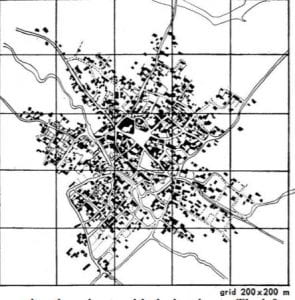
Some towns and cities have an explosion pattern built up over time. They may well have started off as a nucleated settlement but then have grown over time, spread out along main roads finishing with some isolated housing which eventually becomes part of the main settlement. Lisbon is one city that shows an explosion pattern of settlement.
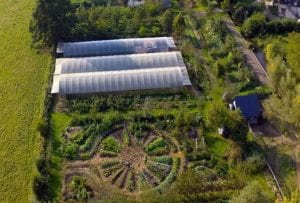 So, how can we use this pattern in design? This is an image of La Ferme du Bec Hellouin in Normandy, France. Below the polytunnels can clearly be seen an exploding pattern set of beds all coming off a central point. Often in walled gardens there would be a well or water store in the centre of this type of pattern, making it quicker and easier to water the beds – or nowadays a tap on a standpipe from a gravity-fed reservoir on higher land. This link gives a closer view of the bed.
So, how can we use this pattern in design? This is an image of La Ferme du Bec Hellouin in Normandy, France. Below the polytunnels can clearly be seen an exploding pattern set of beds all coming off a central point. Often in walled gardens there would be a well or water store in the centre of this type of pattern, making it quicker and easier to water the beds – or nowadays a tap on a standpipe from a gravity-fed reservoir on higher land. This link gives a closer view of the bed.
And finally, spiral patterns.
These are another type of fractal pattern frequently demonstrated through a snail shell, sunflower head, climbing tendrils on sweet peas and in weather systems.

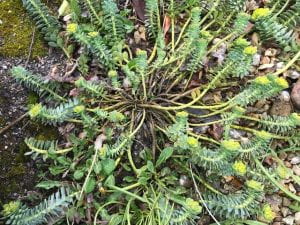
Euphorbia myrsinites
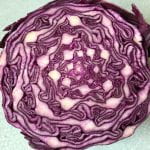
The euphorbia above has a spiral in a spiral. First the leaves spiral around each stem and then each stem spirals out of a central point. I did wonder if the whole plant was an example of an explosion but the stems curl round rather than being straight so I am putting it in the spiral group, not unlike weather patterns. The spiral arrangement of leaves on a plant is to ensure maximum exposure to sunlight and for the seeds. Spirals are able to capture and slow down energy such as in a herb spiral, that ubiquitous permaculture plant bed. To be fair, they are space-saving and allow for different types of herb to be grown, making use of the different amounts of moisture in different parts of the bed.
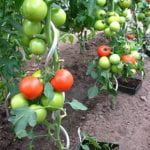
https://www.tomatocages.org/tomatocage/tomato-spirals.html
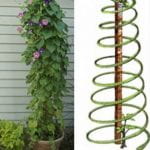

So how else can we use spirals?
I have a number of spiral plant supports which I use for tomatoes in particular. They are tall, narrow spirals which you can twist the stems around as they grow. But there are also other spirals that can be used as plant supports. The third image shows a support that allows climbers to go up and the final one supports flower heads. I use one of these on a peony.
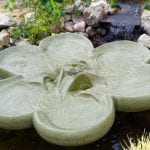 A vortex is a spiral where the air or water swirls around and anything caught in the motion is pulled into the centre. One place where this can be used in the garden is in free flow water features to aerate the water. They are based on an idea from Rudolf Steiner and shown through Drop Test Pictures developed by Theodore Schwenk. Water moves in patterns down a river and creates patterns when a drop is released. Pollution in the water will change the patterns formed so tap water gives a different and lower quality pattern to water fresh from an unpolluted stream. The free form fountains mix water and oxygen together providing support for organisms to break down pollutants and is reported to increase and stimulate plant growth.
A vortex is a spiral where the air or water swirls around and anything caught in the motion is pulled into the centre. One place where this can be used in the garden is in free flow water features to aerate the water. They are based on an idea from Rudolf Steiner and shown through Drop Test Pictures developed by Theodore Schwenk. Water moves in patterns down a river and creates patterns when a drop is released. Pollution in the water will change the patterns formed so tap water gives a different and lower quality pattern to water fresh from an unpolluted stream. The free form fountains mix water and oxygen together providing support for organisms to break down pollutants and is reported to increase and stimulate plant growth.
Do you use any patterns from nature in your garden?
 A book I have bought to read as a result of this module on patterns in nature is Patterns in Nature: Why the natural world looks the way it does by Philip Ball.
A book I have bought to read as a result of this module on patterns in nature is Patterns in Nature: Why the natural world looks the way it does by Philip Ball.
 Because my patch of land is right by the sea, flow has had a very obvious impact on it, creating the dunes in the first place but wind, water and people continue to shape it. It starts at the eastern end at the entrance/exit to a temporary car park which is necessary for the influx of visitors in the summer. The beach, however, is the other side of the road so most people that come out of the carpark need to cross the road and the quickest way to do so is walk up the patch of land to get to the edge of the road. These shortcuts, known as desire lines, usually show designers where they have got things wrong! They are the paths or flows of least resistance and the land can become quite eroded depending on the number of feet that pass by on them. The path also doesn’t go straight up or down but comes in at an angle.
Because my patch of land is right by the sea, flow has had a very obvious impact on it, creating the dunes in the first place but wind, water and people continue to shape it. It starts at the eastern end at the entrance/exit to a temporary car park which is necessary for the influx of visitors in the summer. The beach, however, is the other side of the road so most people that come out of the carpark need to cross the road and the quickest way to do so is walk up the patch of land to get to the edge of the road. These shortcuts, known as desire lines, usually show designers where they have got things wrong! They are the paths or flows of least resistance and the land can become quite eroded depending on the number of feet that pass by on them. The path also doesn’t go straight up or down but comes in at an angle.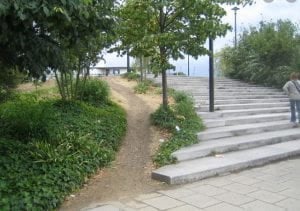 It would be quite possible to build a set of steps here that flare out at the bottom, mirroring the erosion but would what happened in this picture happen because we know it is just quicker to walk up. Actually, in this instance I would formalise that path as well so that people have a choice about which to use.
It would be quite possible to build a set of steps here that flare out at the bottom, mirroring the erosion but would what happened in this picture happen because we know it is just quicker to walk up. Actually, in this instance I would formalise that path as well so that people have a choice about which to use.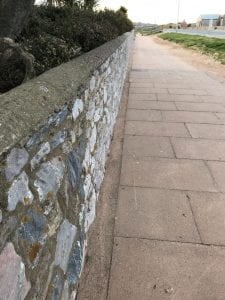 I have talked about the wind and the impact it has on this patch of land and some of its edges before but this patch has one difficult, solid edge where a wall and pavement meet. In a southerly blow, the sand hits the wall and drops to the base where one of the road sweepers that keep the beach area looking neat and tidy sweeps up the sand and puts it in his cart to empty it else where I am presuming. I have often wondered what would happen if they didn’t. Would that paved area fill up eventually and join up with the dune/land at the same level?
I have talked about the wind and the impact it has on this patch of land and some of its edges before but this patch has one difficult, solid edge where a wall and pavement meet. In a southerly blow, the sand hits the wall and drops to the base where one of the road sweepers that keep the beach area looking neat and tidy sweeps up the sand and puts it in his cart to empty it else where I am presuming. I have often wondered what would happen if they didn’t. Would that paved area fill up eventually and join up with the dune/land at the same level?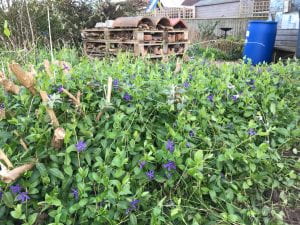 I have two goals this year for the wildlife garden on the allotments. The first is to sort out the bed under the apple tree. It has become overrun with vinca, which has run half way down the plot and will run down the other half if I don’t take action now.
I have two goals this year for the wildlife garden on the allotments. The first is to sort out the bed under the apple tree. It has become overrun with vinca, which has run half way down the plot and will run down the other half if I don’t take action now.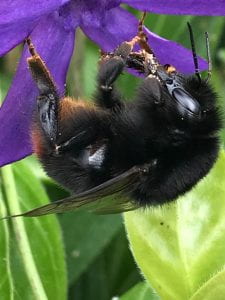
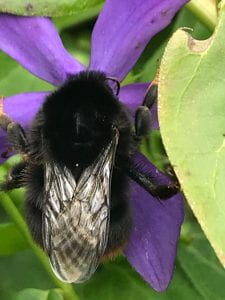
 I was given a couple of books for Christmas about soil. I read the fun-looking one a while ago but left the more serious one,
I was given a couple of books for Christmas about soil. I read the fun-looking one a while ago but left the more serious one, 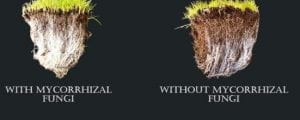
 The best way to support fungi is to spread a compost made with more brown material than green with the addition of rock dust if you have it. After this has been spread you could then mulch with wood chippings which will break down more slowly. I was thinking about raspberry canes when I read this.
The best way to support fungi is to spread a compost made with more brown material than green with the addition of rock dust if you have it. After this has been spread you could then mulch with wood chippings which will break down more slowly. I was thinking about raspberry canes when I read this.
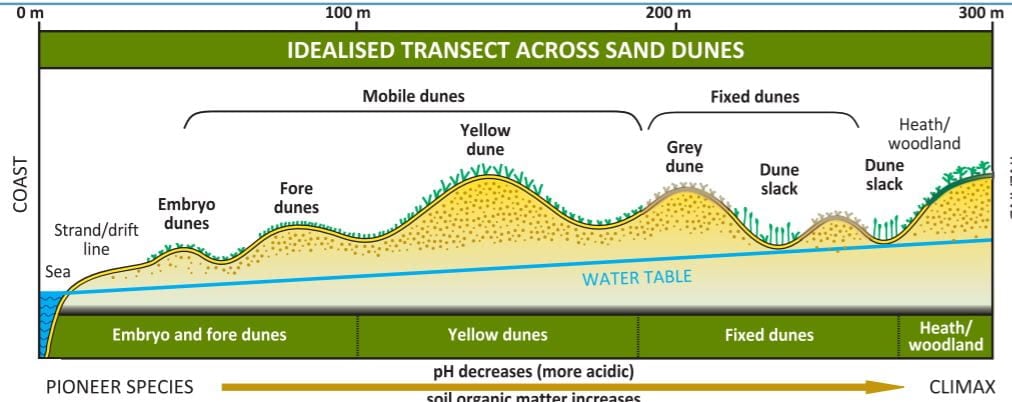
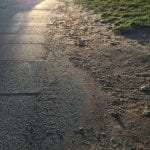
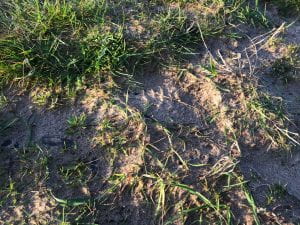 In order for sand dunes to be made, you need two media, sand and wind, where the wind blows sand, deposits it and then blows it away again. In geographic terms, deposition and erosion. Whilst the dunes behind the beach are quite stable, this piece of land has mini dunes on it. The wind blows the sand which gets trapped by the grass on the land and is then eventually blown off, hitting the wall opposite it and deposited at the base of the wall. The ripples in the sand come from the patterns on the base of trainers rather than anything nature has created. Although hard to see, the pattern is again a wave pattern.
In order for sand dunes to be made, you need two media, sand and wind, where the wind blows sand, deposits it and then blows it away again. In geographic terms, deposition and erosion. Whilst the dunes behind the beach are quite stable, this piece of land has mini dunes on it. The wind blows the sand which gets trapped by the grass on the land and is then eventually blown off, hitting the wall opposite it and deposited at the base of the wall. The ripples in the sand come from the patterns on the base of trainers rather than anything nature has created. Although hard to see, the pattern is again a wave pattern.

 In nature there are a limited number of patterns but an infinite number of variations. Take a snowflake: there are no two snowflakes that are the same although they are all formed in a similar way.
In nature there are a limited number of patterns but an infinite number of variations. Take a snowflake: there are no two snowflakes that are the same although they are all formed in a similar way.




 This explosion, however, is the dried flower of Allium x ‘Globemaster’ with some seeds left in the seedheads. The flowerhead is made up of hundreds of little flowers in a beautiful purple during late May early June. It is an excellent example of a pattern within a pattern within a pattern because it is an explosion making a sphere with some branching at the end of each individual flowerhead. You get a really clear picture of how the seeds are dispersed all around the plant, some near and some slightly further away.
This explosion, however, is the dried flower of Allium x ‘Globemaster’ with some seeds left in the seedheads. The flowerhead is made up of hundreds of little flowers in a beautiful purple during late May early June. It is an excellent example of a pattern within a pattern within a pattern because it is an explosion making a sphere with some branching at the end of each individual flowerhead. You get a really clear picture of how the seeds are dispersed all around the plant, some near and some slightly further away.
 So, how can we use this pattern in design? This is an image of La Ferme du Bec Hellouin in Normandy, France. Below the polytunnels can clearly be seen an exploding pattern set of beds all coming off a central point. Often in walled gardens there would be a well or water store in the centre of this type of pattern, making it quicker and easier to water the beds – or nowadays a tap on a standpipe from a gravity-fed reservoir on higher land.
So, how can we use this pattern in design? This is an image of La Ferme du Bec Hellouin in Normandy, France. Below the polytunnels can clearly be seen an exploding pattern set of beds all coming off a central point. Often in walled gardens there would be a well or water store in the centre of this type of pattern, making it quicker and easier to water the beds – or nowadays a tap on a standpipe from a gravity-fed reservoir on higher land. 


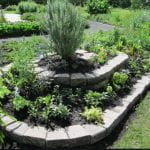



 A vortex is a spiral where the air or water swirls around and anything caught in the motion is pulled into the centre. One place where this can be used in the garden is in free flow water features to aerate the water. They are based on an idea from Rudolf Steiner and shown through
A vortex is a spiral where the air or water swirls around and anything caught in the motion is pulled into the centre. One place where this can be used in the garden is in free flow water features to aerate the water. They are based on an idea from Rudolf Steiner and shown through  A book I have bought to read as a result of this module on patterns in nature is
A book I have bought to read as a result of this module on patterns in nature is 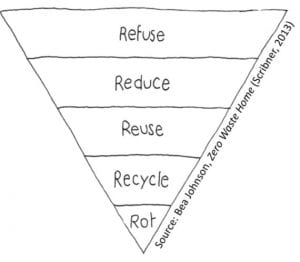 Whatever we take, we must return.
Whatever we take, we must return.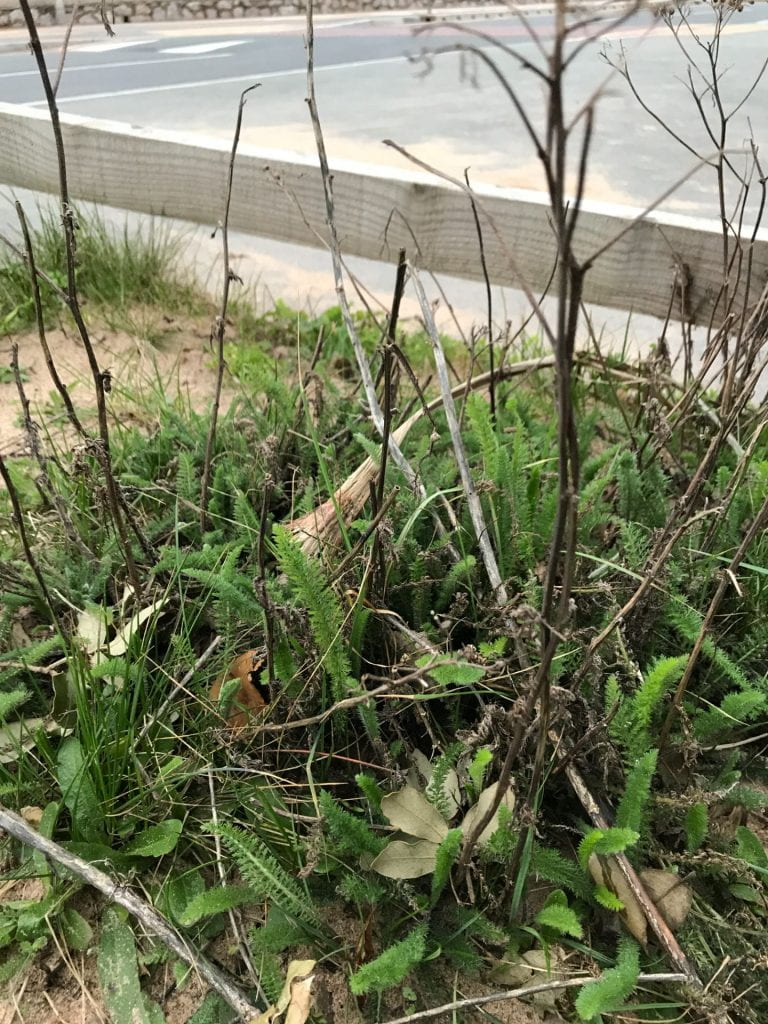
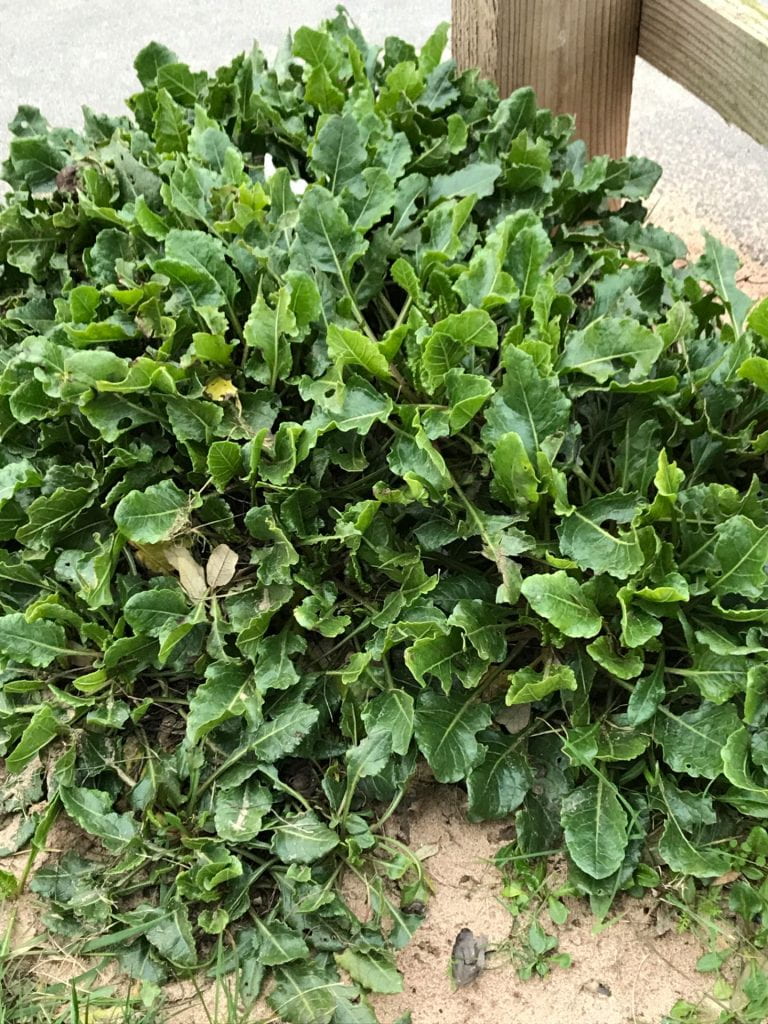
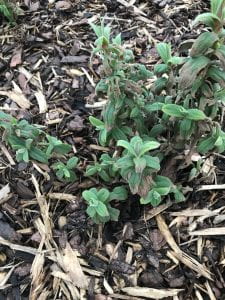
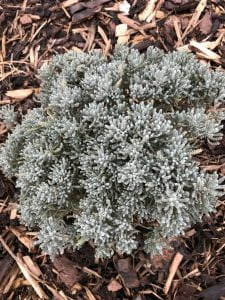
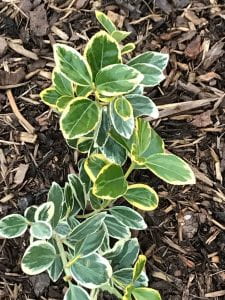

 It is still behind the buildings but at the edge and probably is just not protected enough.
It is still behind the buildings but at the edge and probably is just not protected enough.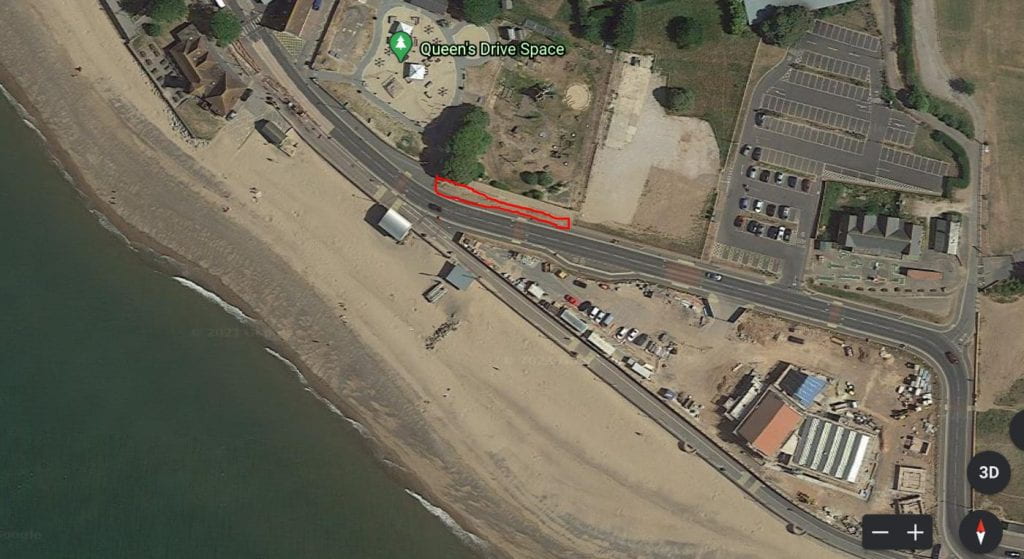
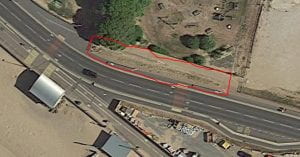
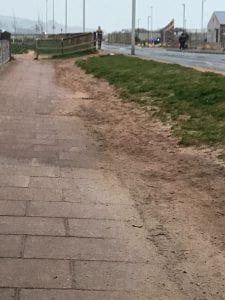 The land is quite steeply sloped down to the pavement and the pavement has a slight slope towards the land. What this means is that when it rains, a large puddle builds up because the one and only drain fills up with sand over time. I am also pretty sure that the drain leads straight through to the beach and the water is not spread throughout the patch of land ready to be used by the plants that are there.
The land is quite steeply sloped down to the pavement and the pavement has a slight slope towards the land. What this means is that when it rains, a large puddle builds up because the one and only drain fills up with sand over time. I am also pretty sure that the drain leads straight through to the beach and the water is not spread throughout the patch of land ready to be used by the plants that are there.